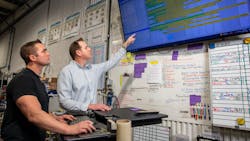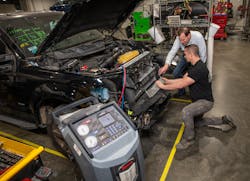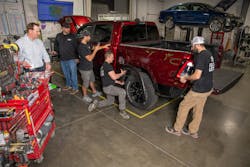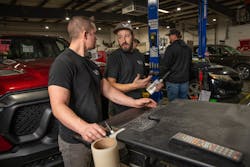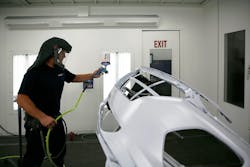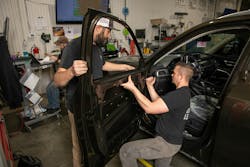It’s probably no surprise to most readers that respondents to the 2023 FenderBender Industry Survey cited finding qualified workers to be the number-one challenge facing the industry. Casey Lund is owner of Collision Leaders, with eight locations in Missouri and Kansas, and Jordan Beshears is vice president of Steve's Auto Body, with two locations in the east metro St. Louis area of Illinois. The two independent MSO owners mold their staff to be more capable and to be responsible for their own success. And they take the processes that work well and replicate them in their other shops. Twenty-six percent of Industry Survey respondents were MSOs.
Ryan Seever, body technician at Collision Leaders’ (formerly Warrensburg Collision) Warrensburg, Mo., location, was named the top shop worker in the 2019 FenderBender Awards and has been with the company over 10 years. He started when the company was doing less than $2 million in sales and “has been a huge part of our success,” Lund said. The company has since grown to eight locations and over $20 million in annual sales, and Seever now leads his own production team, with a concentration on lean management.
“In 2012 or 2013, we really started diving into coaching our people to be leaders, hence why we named our company Collision Leaders when we rebranded last year,” Lund says. “We encourage everybody that they can have an impact on the business.”
‘Winners lose more than losers lose’
Staff are encouraged to implement new ideas without asking for permission, even if they ultimately may not work. Nobody works on commission, and nobody gets fired for making a mistake, Lund says. “Winners lose more than losers lose,” he notes, because “Winners try and fail until they win. We coach them through how to discover those ideas, and how to see waste inside of processes.” Those processes may include how to standardize how to better organize tools so that it’s a repetitive process, or bigger picture items such as how vehicles are painted and how the “X-ray” blueprint process is performed. “And so in doing so, they own the process, because it was their idea.”
Of survey respondents, 31% attend industry-specific management training at least annually. Lund sends managers to PPG’s Green Belt training, and the lessons learned from that are brought back and taught within the organization.
“It's our people, a bunch of guys just like Ryan, who are leading the charge as we take folks from an acquisition and bring them into our Warrensburg store to work for a month so they can learn our processes. They get direct coaching and peer-to-peer leadership at all levels of the organization. It's a culture of how we treat each other, how we can communicate and respect opinions. And that kind of breaks down the barriers as well. I encourage them to try new things, to fail. And I teach them skills outside of fixing cars; I teach them leadership/managerial skills.”
Continuous improvement takes center stage at morning meetings
Each day at each location, preceding the typical production meeting, an employee is tasked with reciting the eight wastes of lean production: overproduction, excess inventory, motion, transportation, defects, overprocessing, waiting (or time) and wasted employee potential. The employee then notes the waste he has seen and how to correct it.
“As employees, we started noticing how much waste we were swimming in on a daily basis at our jobs,” Seever says. Casey empowered us and challenged us, the people who see the waste firsthand, to fix it. He's changed our mindsets to not just go through life thinking ‘This sucks and that's how it is,’ to fix it and make it better. Whining, blaming, and complaining isn't going to make anything better. Instead, he's changed our mindsets to, ‘What can I do to improve it?’”
Those improvement suggestions are shared with the team during the morning meeting, Seever says, which can “spark ideas among other employees and spread through the shop like wildfire.”
“Casey has built a culture of continuous improvement. We take time out of every day to get better, and we also do a lean learning every day at our morning meeting. Casey doesn't just boss us around; he teaches us the ‘why’ behind lean and a bigger systems view of the shop. And he's led us into building repeatable processes that are defect-free.”
Lean learning
Next up in the meeting is the "lean learning component, Lund says, either discussing a book, or more typically, watching a video.
"Sometimes it's about fixing cars, from, Collision Advice, SCRS, or I-CAR, or sometimes it's about Dave Ramsey and how do we invest and make our personal lives better? But we're going to learn something, because we're trying to create that culture that we learn every day. And then after that, we're going to share any good news that we had. It's kind of team building things like, ‘My daughter made the honor roll,’ or ‘My son hit a home run,’ or 'I finally paid off the house,' whatever that is just about personal success."
Sharing improvements
The next component in each meeting is on sharing improvements.
"So this is the improvement that I made yesterday, to make myself or the shop better. Sometimes, we do show-and-tell, because it's something that will affect everybody: 'I made a home for this broom or this tool.' And they'll present that to people so that everybody knows. And then my improvement a lot of times inspires other people. It's like the first time somebody used the Kaizen foam stuff [for organizing tools], the next day I was out of Kaizen foam, because everybody was trying to duplicate that."
Reducing waste in production
The biggest area of waste, Lund says, is overlooking damage that needs to be captured for the supplement.
“Our goal is to discover all of the supplemental damage, write one good estimate and make it a blueprint – we call it X-ray repair planning – do that day one, and then we shouldn't have to stop production on that car any time once it enters production after it's approved and the parts are there.”
The process works, Lund says. Over the span of many years, the number of repair orders requiring a supplement after the repair planning has been performed has gone down from 90% to only 5%, in a facility fixing about 100 cars a month and over $500,000 in sales.
“It's about identifying the struggle, seeing the waste, and we're employing principles and theory to fix that problem in a way that it doesn't come back,” Lund says. “The Japanese term is Poka-yoke: make it mistake-proof to where we can't screw that up again, so we've now solved that problem. We've got thousands more problems to fix. Check that one off the list. Let's go on to the next one. And that's just kind of how we do it every day.”
At Collision Leaders, Casey wants more than just our hands,” Seever says. “He wants our minds, too, so every day each employee is asked to make the two-second improvement. This can be anything to make your everyday job easier, faster, safer, and better quality. If an improvement fails, it's okay, because Casey knows that they learned from their failure and grew and developed as a person.”
As a simple example, Seever says, receiving an incorrect part can create multiple types of (lean) waste, especially if it’s not caught until late and halts the production process. The solution to that would be to mirror-match new parts to old as they are received. Another example of waste at Collision Leaders was not having a process to identify all unrelated prior damage (UPD.)
“Now as part of our check-in process, we go around and take UPD photos all over the car. And that's eliminating that extra waste of having to fix something for free and doing all that overprocessing. All our technicians have CCC on their cell phone. So as they're fixing the car, as they’re X-raying the car, they're adding the photos, we're basically trying to tell a story that goes along with our estimate, to be fully transparent as to everything that we did to the vehicle. We want to do a good-quality job, get paid for just what we're doing and nothing extra, really. We as technicians try to provide photos and information along the way to help document for our estimator, if they need to prove to the insurance company or anybody else to show what we did.
“We added the process of identifying UPDs because we got tired of fixing things for free.”
The process includes documenting the condition of lights, fluids, and the battery.
“A lot of these little defects that every body shop has, we've just gone through the mindset of not just thinking that this how it is, and ‘Oh, shoot, we’ve got to buy a battery.’ We've changed our mindset to, ‘What can we do to stop this from happening?’ So we catch it in the beginning, you know, we do these check ins, we do battery tests, we do fluids and light checks, and we document all this before we even start working on the vehicle.”
‘A rising tide raises all ships’
Jason Shup has been the painter at Steve’s Auto Body’s O’Fallon, Illinois, location since 2004. Beshears says Shup's skill sets as a painter are at a “very, very high level,” but Shup also excels at “trusting what we're doing, believing in what we're doing, following the process, and then buying into how we need younger people to help us as a team move forward. It's kind of like the old adage: ‘A rising tide raises all ships.’ He really buys into that.”
As an example, Beshears, says, he had to fire a painter at the Belleville location. Shup’s prepper had been doing his job for seven years. Beshears thought he was ready to be challenged in a new role.
“He was really comfortable in the role of being a prepper, but we felt that he put his time in it and deserved the opportunity to become a painter at the other store,” Beshears says. “So my dad and I talked about it. We brought Jason in, and without hesitation, Jason said, ‘Yeah, he's earned the right,’ which I think says a lot about him. Because at the end of the day, that put him back to square one with training another prepper. He could have easily said no and kept him for himself. But he knew that it was best for Matt and best for the company for him to take this next step.”
Seventy-three percent of respondents reported their teams attend I-CAR training annually. Shup says not only does Beshears keep him current on I-CAR certified training and PPG certification at the Kansas City, Missouri, training center, but he makes sure their local paint representative visits monthly, which can be a big help to advance younger employees’ skills for spraying newer, more complicated colors, or proper priming techniques for the preppers. Sixty-five percent of survey respondents send their staff to paint company training.
Setting expectations
“Jason's had to adapt to his position being more of a leadership role, Beshears says. “Kids nowadays are just different. It's harder to motivate people…or it's harder to figure out what motivates people. I think we've seen some evolution in him in terms of his leadership. How he's approached dealing with the younger generation has changed, as it has for all of us, because we've realized once we've had to do it, you have to adapt to how these kids are or it's just going to be a constant beating your head off a wall.”
Consistency allows for staff to advance within the organization at Steve’s Auto Body, Shup says.
“What Jordan is trying to do is duplicate everything in all the shops. If it’s time for somebody to move up, he can just plug him in here and he already sort of knows the expectations, which is huge. He’s real good about, ‘Hey, I’ve hired this person to do this job. I’m going to let them do their job; they’re the ones who trained to do that. If they’re not doing their job, I’m going to say something.’ I think that’s huge of him to have trust in us, because I’ve worked with some other people who want to second-guess what you’re doing.”
And then currently here I have a kid that just graduated high school that's really interested in it, so we're working him up a little bit and hopefully at some point he gets, you know, a store down the road or something.
Shup says Beshears excels at placing people in the right positions to capitalize on their strengths.
“Say we have a guy who likes cutting off quarter panels. Well, guess what he's doing most of the time?”
Instead of one technician keeping the repair job from start to finish (of the body repair,) Shup says, Beshears is trying to place technicians in positions that allow the job to be broken down in smaller portions.
“So, I think that's been a huge, huge part that's helped out a lot. Just the vibe around here is different from 2004, where we're more of a team now. Back then, it seemed like it was more ‘I'm all about myself.’ That makes for better morale in the shop.”
Building up and not tearing down
Seever shared that sentiment.
“Everyone around here is a leader. Everyone's opinions and ideas are valued from the bottom all the way to the top. I think that's the mindset is that everyone knows that they can learn something from somebody, and we're all about building people up and not tearing them down.”
As the suggested improvements from the morning meetings are implemented, “one guy will see a little improvement, and he'll be like, ‘Oh, man, I could tweak that a little bit for me and make it work for me here.’ Once we have a baseline process, at least we have something we can tweak and improve on from there. And we are continuously still tweaking our shop processes to make them better and better.”
When the first changes were implemented, the shop was shut down for several days. We in the shop made our processes: ‘Why do we tear the car down like this?’ And then we just created a standard. Every technician who was working at the shop at that time was a part of the decision-making of our processes. So since we were involved in making the processes, we had no reason to be upset or against them because they were all our own ideas. And still to this day, if we want to change something, it's our baby.”
Allow the team to contribute
“My leadership philosophy is to do less and allow others to do more. I believe that we rob people of their potential in what they can become in life," Lund says. "And I think we fail as leaders to do that. We rob ourselves of our potential by not allowing our team to contribute to their fullest ability. It's not a competition. We're all in competitions with ourselves, not each other. We’re trying to promote each other to get better. And by my friend over here getting better, I'm actually going to get better as well. Because he's going to rub off on me, or he's going to teach me, or I'm going to learn by watching him.”
Lund knows the authority for his staff to readily make changes is different from how many other shops run.
“They can change the business; they can implement systems — we have to teach them how to do that. But once we do that, they don't need my permission to do stuff, you would think it was their business when you hear them speak. And they take that much pride and ownership in what we do and in wearing that logo on their jersey or on their uniform. It makes them proud not of what I did, but because of what they did and their contribution. And I'm proud of what they do as their contribution, because that's the secret sauce that has gotten us to where we are.”
26%
of Industry Survey respondents were MSOs
31%
attend industry-specific management training at least annually
73%
of respondents' teams attend I-CAR training annually
65%
send their staff to paint company training
About the Author
Jay Sicht
Editor-in-Chief, FenderBender and ABRN
Jay Sicht is editor-in-chief of FenderBender and ABRN. He has worked in the automotive aftermarket for more than 29 years, including in a number of sales and technical support roles in paint/parts distribution and service/repair. He has a bachelor's degree in journalism from the University of Central Missouri with a minor in aviation, and as a writer and editor, he has covered all segments of the automotive aftermarket for more than 20 of those years, including formerly serving as editor-in-chief of Motor Age and Aftermarket Business World. Connect with him on LinkedIn.
Don't miss Jay's next article or podcast. Sign up for FenderBender Today's Collision Repair News and ABRN eNews here.
